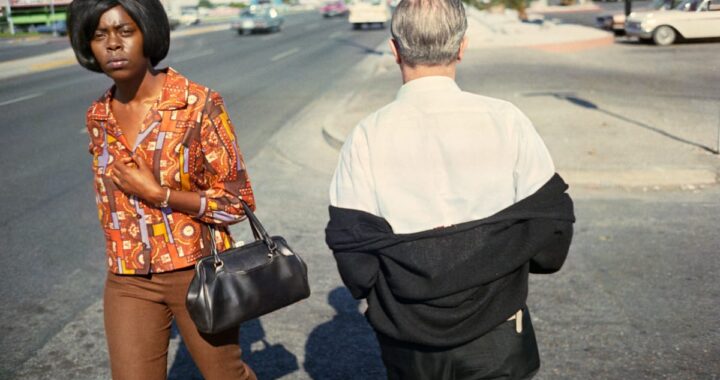For Eggleston (1939), execution and composition are not the primary focus. Instead, he aims to imbue his photos with a particular feeling. Feeling? You can indeed let your mind run wild when looking at his images. They are at once familiar and disturbing.With art curator Walter Hopps he made a road movie in America of the sixties and seventies that would become known as the ‘documentary’ Los Alamos. Hopps behind the wheel, Eggleston with his Leica at the ready, he would approach his subjects directly, without much thought, to avoid doubt creeping in. One of the images he captured became his very first color photograph: a young shop assistant pushing a row of supermarket carts in front of him. He also documented vast landscapes, exuberant clothing and hairstyles, and car tail fins. You immediately feel like taking a road trip through the States.
Eggleston’s images also do well on album covers. Take, for example, Like Flies On Sherbert by Alex Chilton (singer-guitarist of cult band Big Star from Memphis). The cover features toy dolls arranged innocently on the hood of a car. But if you play the record you’ll hear rock songs that sound more drunk than sober. The photographer was once friends with Chilton’s parents, who managed an art gallery in Memphis. The cover of another Big Star album, Radio City shows an ominous close-up of a lightbulb against a bright red ceiling.
Eggleston has a fondness for red. And for many other warm-blooded colors that don’t occur naturally. He used the “dye-transfer” technique, which was previously employed in advertising photography. Technically, it involves a combination of sophisticated lighting and development with colored filters. This almost traditional process has long fallen out of use. However, it provides the opportunity to add or intensify nuances in images. This comes in handy because Eggleston photographs, in his own words, “the ugly stuff.” Raw ‘still lifes’ of abandoned streets, gas stations, cars, supermarkets, and empty houses. The fact that the seemingly ordinary can still leave an indelible impression is one of the great mysteries in his work.
His work has since influenced others. It laid the red carpet for films by directors like David Lynch. Take another close look at No Country For Old Men or, more specifically Nocturnal Animals. In some shots, you can immediately recognize Eggleston’s signature. Recognition, however, came slowly for the photographer himself. It wasn’t until 1976 that he received his first major exhibition at the Museum Of Modern Art.
The accompanying catalog was in fact the museum’s very first publication on color photography. This is quite bizarre when you consider that films in the early 20th century were increasingly moving away from black and white. Color television made its debut in the 1950s. William Eggleston is now regarded as the “godfather” of color photography.


